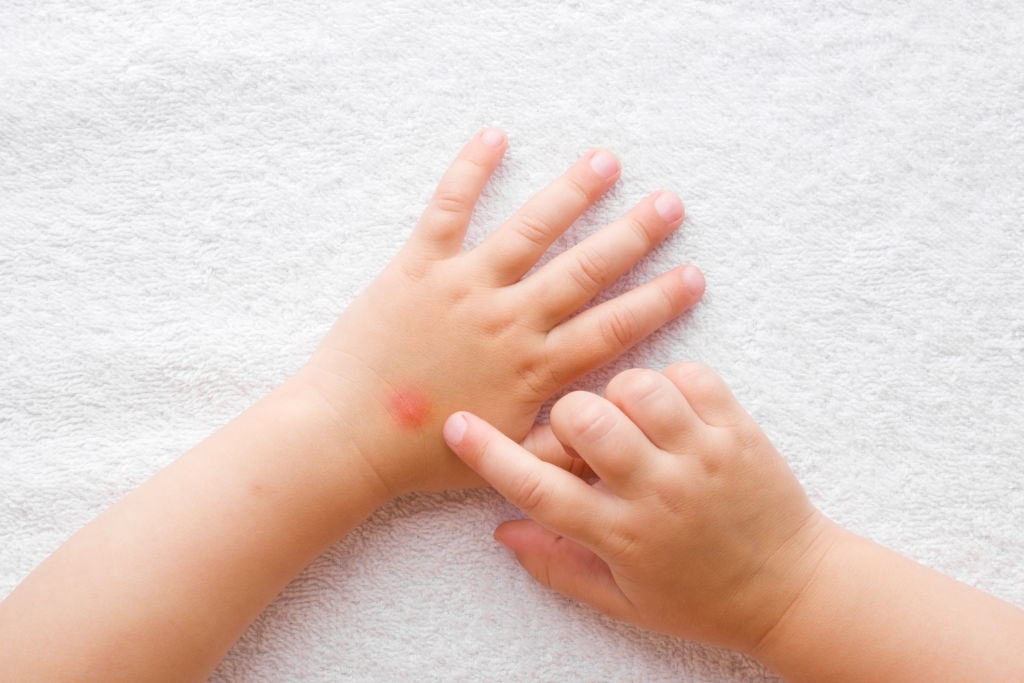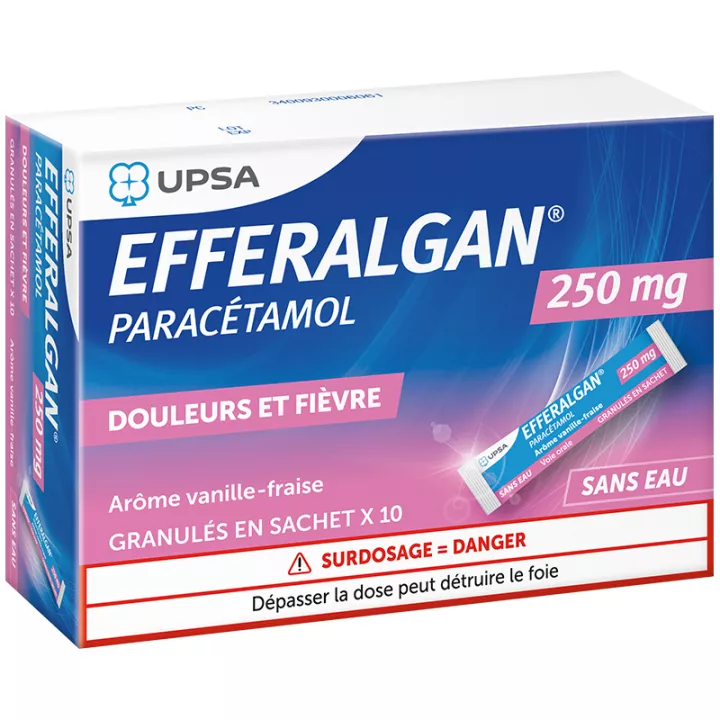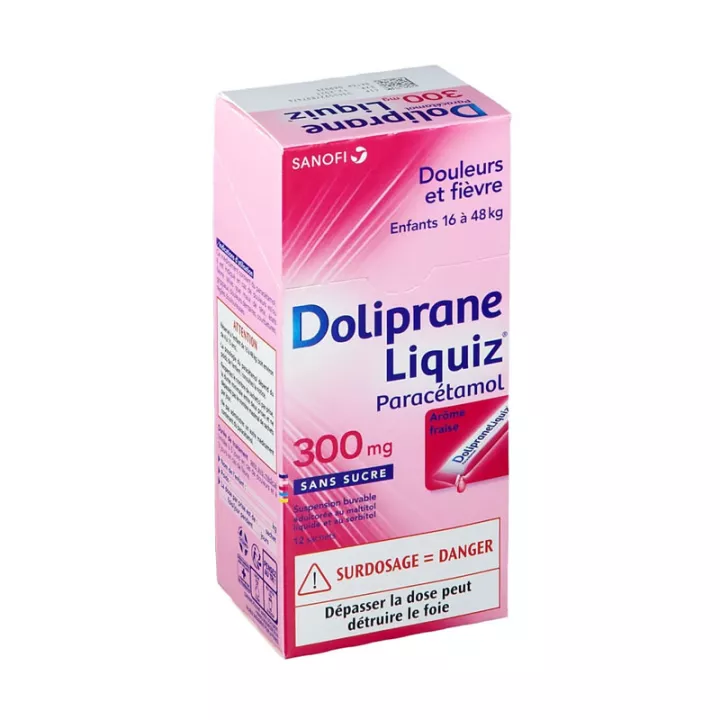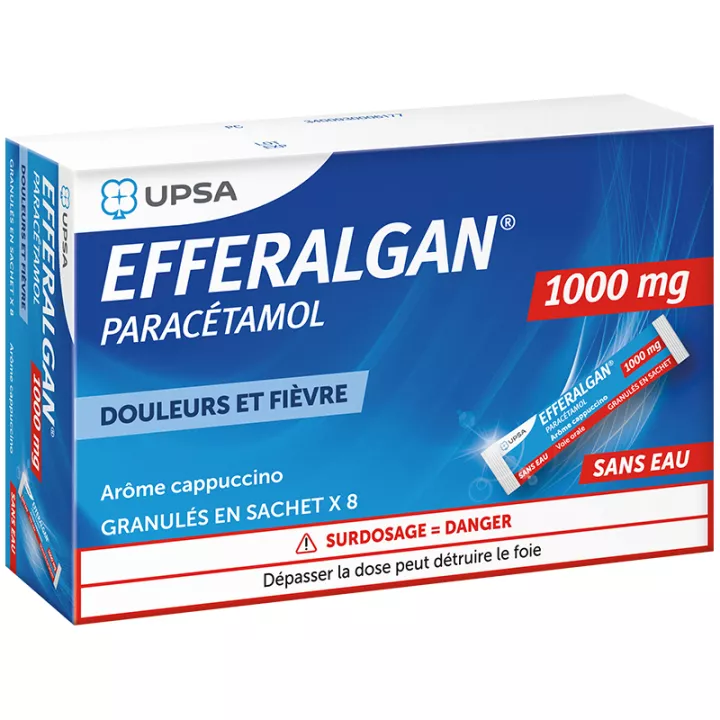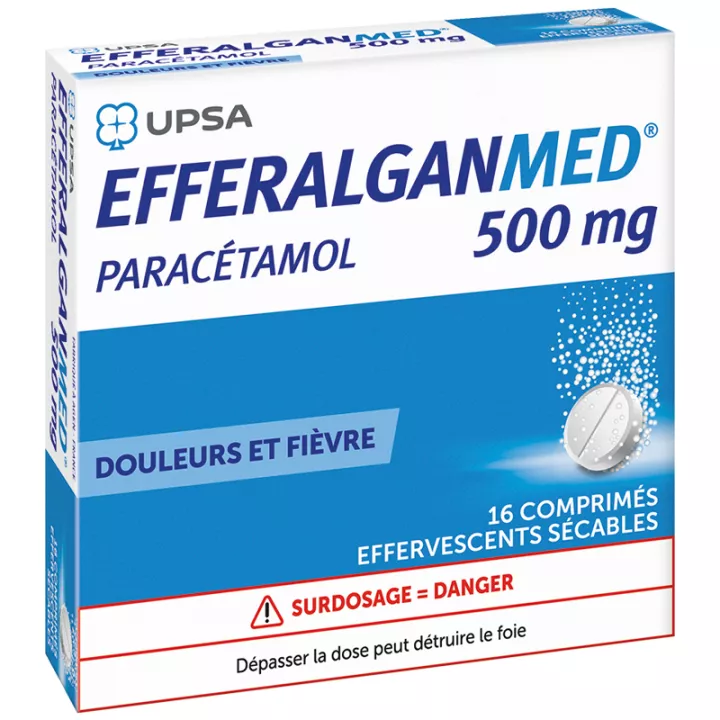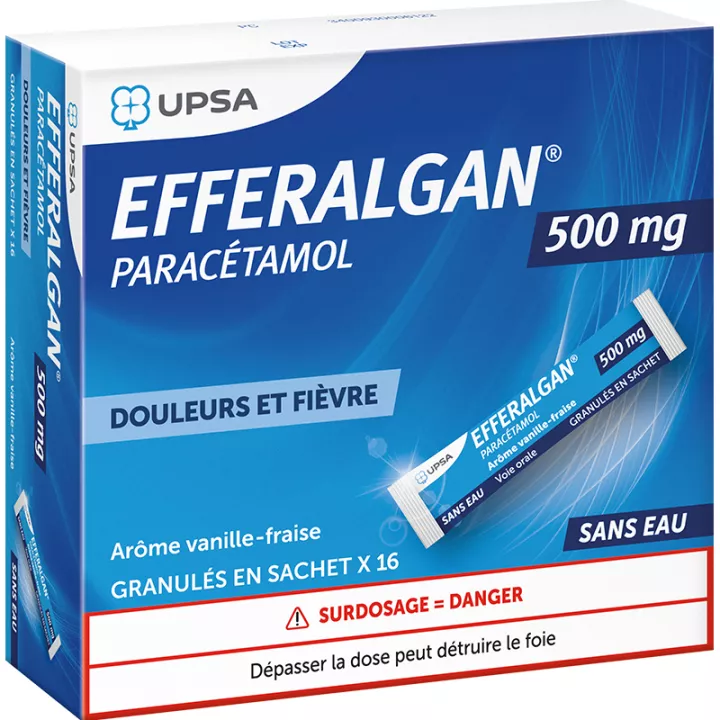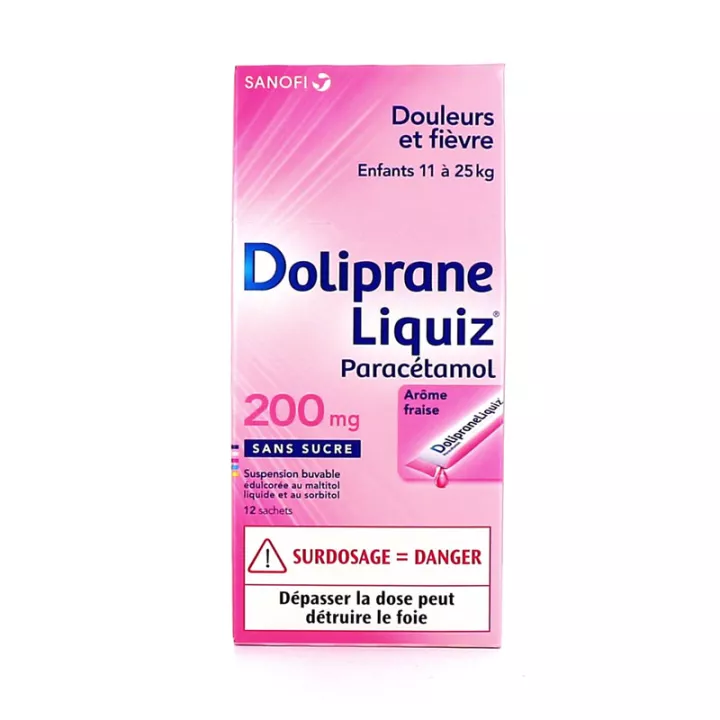NOTICE
ANSM - Last updated: 06/12/2016
Name of the medicinal product
EFFERALGAN 250 mg, granules in sachets
Paracetamol
framed
Please read this leaflet carefully before you start taking this medicine because it contains important information for you.
You should always take this medication exactly as prescribed in this leaflet or by your doctor, pharmacist or nurse.
· Keep this leaflet. You might need to read it again.
· Ask your pharmacist for advice or information.
· If you experience any of the side effects, talk to your doctor, pharmacist or nurse. This also applies to any side effects not mentioned in this leaflet. See section 4.
· You should contact your doctor if you experience no improvement or feel less well after 3 days in case of fever and 5 days in case of pain.
Do not use this medication for children.
What is in this leaflet?
1. What is EFFERALGAN 250 mg, granules in sachets and in which cases it is used?
2. What information should I take before taking EFFERALGAN 250 mg, granules in sachets?
3. How to take EFFERALGAN 250 mg, granules in sachets?
4. What are the possible side effects?
5. How to store EFFERALGAN 250 mg, granules in sachets?
6. Package contents and other information.
1. WHAT IS EFFERALGAN 250 mg, granules in sachets AND IN WHAT CASES IS IT USED?
EFFERALGAN 250 mg, granules in sachets is indicated for the symptomatic treatment of low and moderate pain and / or fever.
2. BEFORE YOU TAKE EFFERALGAN 250 mg, granules in sachets?
Never take EFFERALGAN 250 mg, granules in sachets:
· if you are allergic to paracetamol or to any of the other ingredients of this medication mentioned in section 6.
· if you have severe liver disease (hepatic insufficiency or decompensated progressive disease of the liver).
Warnings and Precautions
Talk to your doctor or pharmacist before taking EFFERALGAN 250 mg, granules in sachets
· if you weigh less than 50 kg
· in mild to moderate hepatic insufficiency (liver disease)
· in the case of chronic alcoholism, excessive alcohol consumption (3 or more alcoholic beverages per day)
· in patients with renal insufficiency (severe kidney disease) (see also "3. How to take EFFERALGAN 250 mg, granules in sachets?")
· if you have Gilbert's syndrome (non-haemolytic familial jaundice)
· if you are taking other medicines that have an effect on your liver at the same time as EFFERALGAN 250 mg, granules in sachets
· if you have a glucose-6-phosphate dehydrogenase deficiency
· in case of haemolytic anemia (abnormal decrease in the number of red blood cells and hemoglobin)
· if you are suffering from chronic malnutrition (low reserves of liver glutathione)
· if you are dehydrated (excessive loss of body water)
· if you have acute viral hepatitis or if this disease is diagnosed while taking EFFERALGAN 250 mg, granules in sachets. Talk to your doctor as it may stop treatment with EFFERALGAN 250 mg, granules in sachets.
Before starting treatment with this drug, check that you are not taking any other medicines containing paracetamol.
Do not continue treatment without consulting your doctor:
· if the pain persists for more than 5 days or if the fever persists for more than 3 days ;
· if the drug does not appear to be effective enough;
· if any other health problem occurs.
IN CASE OF DOUBT, DO NOT HESITATE TO CONSULT YOUR PHYSICIAN OR PHARMACIST.
Children and Youth
When a child is treated with paracetamol, the association of another fever medication is justified only in case of ineffectiveness. Any combination with several medications should be initiated and supervised by a physician.
The use of EFFERALGAN 250 mg, granules in sachets is reserved for children and teenagers weighing between 14 and 50 kg (from 2 to 12 years approximately).
Other medicines and EFFERALGAN 250 mg, granules in sachets
Inform your doctor or pharmacist if you are taking, have recently taken or could take any other medicines, including if these medicines have been obtained without a prescription.
Medicines that can modify the effects of EFFERALGAN 250 mg, granules in sachets :
· Probenecid (drug used for the treatment of gout). A reduction in the dose of EFFERALGAN 250 mg, granules in sachets may be necessary, as probenecid increases the concentration of paracetamol in the blood.
· Phenobarbital, phenytoin, carbamazepine, primidone (drugs used for the treatment of epilepsy) and rifampicin (drug used for the treatment of tuberculosis). The use of these medications at the same time as paracetamol may cause liver damage.
· AZT (zidovudine, a drug used for the treatment of HIV infection). The use of paracetamol at the same time as AZT may reduce the number of white blood cells (neutropenia). Thus, EFFERALGAN 250 mg, granules in sachets should not be taken at the same time as zidovudine except on medical advice.
· Metoclopramide (medication used for the treatment of nausea) and other drugs that accelerate the emptying of the stomach. These medicines can increase absorption and accelerate the occurrence of the effect of EFFERALGAN 250 mg, granules in sachets .
· Medicines slowing the emptying of the stomach. These medicines can delay absorption and delay the effect of EFFERALGAN 250 mg, granules in sachets .
· Cholestyramine (medication used to reduce high levels of lipids in the blood). This drug may reduce absorption and delay the effect of EFFERALGAN 250 mg, granules in sachets . Therefore, you should not take cholestyramine within 1 hour of taking paracetamol.
· Oral anticoagulants, particularly warfarin (blood thinning drugs). Repeated use of paracetamol for more than one week increases the risk of bleeding. The use of paracetamol in the long term should therefore only be done on medical advice. Occasional intake of paracetamol has no significant effect on the risk of bleeding.
· Aspirin (or Acetylsalicylic acid, medication used to treat pain and fever) and chloramphenicol (antibiotic agent). A reduction in the dose of aspirin and chloramphenicol, supervised by a physician, may be necessary.
Effect of taking EFFERALGAN 250 mg, granules in sachets on blood tests .
If your doctor prescribes a dosage of uric acid in the blood or blood sugar, tell him or her that you are taking this medicine.
This medicinal product contains paracetamol. Other medications also contain it. In order not to exceed the recommended daily dose, do not combine them (see section 3). If you are taking any other medicines containing paracetamol or propacetamol, you should first consult your doctor or pharmacist.
EFFERALGAN 250 mg, granules in sachets with food and beverages
Not applicable.
Pregnancy, breast-feeding and fertility
If you are pregnant or breastfeeding, think you may be pregnant or plan a pregnancy, ask your doctor or pharmacist for advice before taking this medicine.
Pregnancy
In case of pregnancy, EFFERALGAN 250 mg, granules in sachets should be used only after careful assessment of benefits and risks. In this case, the recommended dose and the duration of treatment should be strictly observed.
During pregnancy, you should not take paracetamol for long periods of time, in high doses or in combination with other medicines.
feeding
EFFERALGAN 250 mg, granules in sachets can be used at recommended doses during breastfeeding.
Sport
Not applicable.
Driving and using machines
Paracetamol has no or negligible effect on the ability to drive and use machines.
EFFERALGAN 250 mg, granules in sachet contains sorbitol (E420) and sucrose.
If your doctor has told you about an intolerance to some sugars, contact your doctor before taking this medicine.
3. HOW TO TAKE EFFERALGAN 250 mg, granules in sachets?
Always take this medication exactly as prescribed by your doctor or pharmacist. Check with your doctor or pharmacist if in doubt.
The maximum daily dose of paracetamol is 60 milligrams (mg) per kg (kg) per day, divided into 4 or 6 doses, ie 15 mg per kg every 6 hours or 10 mg per kg every 4 hours .
Body weight (age) | Single outlet | Interval between each take | Maximum daily dose |
From 14 kg to less than 21 kg
(from the age of 2 to less than 6 years) | 250 mg of Paracetamol
(1 sachet) | 6 hours | 1000 mg of Paracetamol
(4 bags) |
From 21 kg to less than 27 kg
(from the age of 6 to less than 8 years) | 250 mg of Paracetamol
(1 sachet) | 4 hours | 1500 mg of Paracetamol
(6 bags) |
From 27 kg to less than 41 kg
(from the age of 8 to less than 10 years) | 500 mg of Paracetamol
(2 sachets) | 6 hours | 2000 mg of Paracetamol
(8 bags) |
From 41 kg to less than 50 kg
(from the age of 10 to ≤ 12 years) | 500 mg of Paracetamol
(2 sachets) | 4 hours | 3000 mg of Paracetamol
(12 sachets) |
Use in children and adolescents
EFFERALGAN 250 mg, granules in sachets IS RESERVED FOR CHILDREN AND ADOLESCENTS weighing between 14 and 50 kg (from 2 to 12 years approximately).
In children, it is imperative to respect the dosages defined according to the weight of the child and thus to choose a suitable presentation. Approximate ages according to weight are given only as an indication.
In children, the total dose of paracetamol should not exceed 60 mg / kg / day (see table above).
Frequency of Administration
Regular intakes prevent fluctuations in pain or fever:
· In children, they should be regularly spaced, including at night, preferably 6 hours, and at least 4 hours.
· In adolescents, they must be spaced at least 4 hours apart.
Special patient groups
The lowest effective daily dose should be considered, but not more than 60 mg / kg / day (not to exceed 3000 mg / day) in the following situations:
· Adults and adolescents under 50 kg
· Hepatic impairment (liver disease) (mild or moderate)
· Chronic alcoholism
· dehydration
· Chronic malnutrition
· Gilbert's syndrome
No dosage adjustment is necessary in elderly patients .
Renal failure
If you have kidney disease (severe kidney disease), the minimum interval between each dose should be adjusted according to your renal function (assessed on the basis of creatinine clearance) as follows:
Creatinine clearance | Interval between doses |
cl greater than or equal to 50 mL / min | 4 hours |
cl between 10 and 50 mL / min | 6 hours |
cl less than 10 mL / min | 8 hours |
The dose of paracetamol should not exceed 3000 mg per day.
Hepatic insufficiency
If you have a chronic liver disease or a compensated progressive disease of the liver, especially liver failure, chronic alcoholism, chronic malnutrition (low reserves of liver glutathione), Gilbert's syndrome (jaundice non-haemolytic family) and dehydration, the dose of paracetamol should not exceed 2000 mg per day.
Administration mode
Oral use only. Take the pellets directly in the mouth, on the tongue, then swallow them without water.
Duration of administration
As with any pain medication (analgesic), the duration of treatment should be as short as possible and appropriate to the symptoms.
The duration of treatment is limited to: · 5 days in case of pain; · 3 days in case of fever. |
If the pain persists for more than 5 days or if the fever persists for more than 3 days, do not continue treatment without consulting your doctor.
If you take more EFFERALGAN 250 mg, granules in sachets that you should:
Consult your doctor or nearest emergency department immediately if overdose with EFFERALGAN 250 mg, granules in sachets especially in elderly patients, young children, patients with liver disease, chronic alcoholism and patients with chronic malnutrition. Overdose can have very serious consequences and can even lead to death.
Immediate treatment is essential, even if you feel good, due to the delayed risk of severe liver damage. Symptoms may be limited to nausea, vomiting, anorexia, paleness and abdominal pain, and may not reflect the severity of overdose or organ damage.
If you forget to take EFFERALGAN 250 mg, granules in sachets:
Do not take a double dose to make up for the missed dose.
If you have any further questions on the use of this medication, ask your doctor or pharmacist.
If you stop taking EFFERALGAN 250 mg, granules in sachets:
Not applicable.
4. WHAT ARE POSSIBLE SIDE EFFECTS?
Like all medicines, this medicine may cause side effects, although not everybody gets them.
The following side effects may occur:
Rare: can affect up to 1 in 1,000 people
· Anemia, nonhemolytic anemia
· Medullary aplasia, a disease due to a decrease in the production of blood cells, thrombocytopenia, leucopenia and neutropenia (decrease in the number of certain blood cells)
· Edema (abnormal accumulation of fluid in the body)
· Acute and chronic pancreatitis
· Hemorrhage (loss of blood), abdominal pain, diarrhea, nausea, vomiting, hepatic insufficiency, hepatic necrosis, jaundice
· Pruritus, skin rash, sweating, purpura (red or purple spots on the skin), angioedema (rapid swelling of different layers of the skin), urticaria (rash characterized by pale red blisters, accompanied by itching)
· Nephropathy and tubular disorders (kidney disease).
Paracetamol is widely used and reports of adverse effects are rare and in general are associated with an overdose.
Nephrotoxic effects (kidney toxicity) are infrequent and have not been reported at recommended doses except for prolonged administration.
Very rare cases of severe skin reactions have been reported.
Declaration of side effects
If you experience any side effects, talk to your doctor or pharmacist. This also applies to any side effects not mentioned in this leaflet. You can also report adverse reactions directly via the national reporting system: National Agency for the Safety of Medicines and Health Products (ANSM) and network of Regional Centers of Pharmacovigilance - Website: www.ansm.sante.fr
By reporting adverse reactions, you are helping to provide more information about the safety of the drug.
5. HOW TO STORE EFFERALGAN 250 mg, granules in sachets?
Keep this medicine out of the reach and sight of children.
Do not use this medicine after the expiry date which is stated on the packet and after {EXP}. The expiry date refers to the last day of that month.
Store in the original package, away from light and moisture.
Store at a temperature not exceeding 30 ° C.
Do not throw any medication into the sewer or household waste. Ask your pharmacist to remove any medications you are no longer using. These measures will help protect the environment .
6. PACKAGE CONTENTS AND OTHER INFORMATION
What EFFERALAGN contains 250 mg granules in sachets
· The active substance is: paracetamol. Each sachet contains 250 mg of paracetamol.
· Other ingredients are: Sorbitol (E420), talc, basic methacrylate copolymer, light magnesium oxide, sodium carmellose, sucralose (E955), magnesium stearate, hypromellose, stearic acid, sodium lauryl sulfate, titanium dioxide , flavoring of strawberry (contains maltodextrin, gum arabic (E414), natural and natural flavoring substances, propylene glycol (E1520), glyceryl triacetate (E1518), 3-hydroxy-2-methyl- 4H-pyran-4-one (E636)), vanilla flavoring (containing in particular sucrose).
What is EFFERALGAN 250 mg, granules in sachets and contents of the pack
Granules in sachets.
White or almost white pellets.
Box of 8, 10, 16, 20, 48 or 50 sachets.
Not all pack sizes may be marketed.
Marketing Authorization Holder
UPSA SAS
3, RUE JOSEPH MONIER
92500 RUEIL MALMAISON
Marketing Authorization Operator
UPSA SAS
3, RUE JOSEPH MONIER
92500 RUEIL MALMAISON
Maker
LOSAN PHARMA GMBH
OTTO-HAHN-STRASSE 13
79395 NEUENBURG
GERMANY
Names of the medicinal product in the Member States of the European Economic Area
This medicinal product is authorized in the Member States of the European Economic Area under the following names:
In accordance with the regulations.
The last date on which this leaflet was revised is:
To be completed later by the holder.
Other
Health Education Council:
WHAT TO DO IN CASE OF FEVER:
The normal temperature of the body varies from person to person and is between 36.5 ° C and 37.5 ° C. A rise in temperature above 38 ° C may be considered a fever.
If the disorders that the fever causes are too troublesome, you can take this drug that contains paracetamol in accordance with the indicated dosages.
To avoid any risk of dehydration, consider drinking frequently.
With this medication, the fever should drop rapidly. However :
· if other unusual signs appear,
· if the fever persists for more than 3 days or if it worsens,
· if the headache becomes violent, or in case of vomiting,
CONSULT YOUR DOCTOR IMMEDIATELY.
WHAT TO DO IF PAIN:
The intensity of the perception of pain and the ability to resist it vary from person to person.
· If there is no improvement after 5 days of treatment,
· if the pain is violent, unexpected and occurs suddenly (including severe pain in the chest) and / or reverses regularly,
· if accompanied by other signs such as general malaise, fever, unusual swelling of the painful area, decreased strength in a limb,
· if it wakes you up at night,
CONSULT YOUR DOCTOR IMMEDIATELY.
